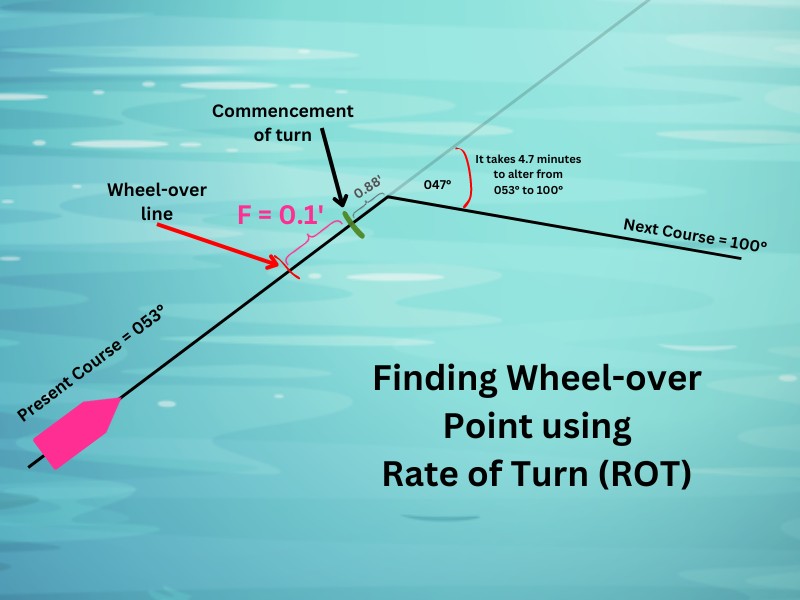Identifying the correct wheel-over point during course alteration can be a lifesaver, especially for newly promoted officers who just got their hands on the wheel.
If not done correctly, your vessel could overshoot resulting in accidents, or alter early without hitting the waypoint, which can be viewed as “cutting corners”.
I’ve read many reports about that, and it’s one of the favorite things inspectors check on your Electronic Chart Display and Information System (ECDIS).
If you don’t want to be on the next fleet advisory because of these observations, let’s calculate the wheel-over position of your vessel every time it alters her course.
Key Takeaways
- The wheel-over point (WOP) marks the start of a course change maneuver when the helm applies a rudder.
- Two methods exist to calculate WOP; Parallel Indexing and the Rate of Turn (RoT) method.
- Knowing the WOP prevents overshooting or undershooting waypoints, ensures safe and efficient navigation, and helps avoid inspector observations during audits.
What is Wheel-Over Position?
The wheel-over position (WOP) is the point in your chart where the helmsman or autopilot system applies the rudder to initiate the desired change in course.
It essentially marks the start of the turning maneuver from your present course to the next one.
Marked as a line, the WOP is plotted on the chart as part of the voyage plan, as it serves as a guide for OOWs that a turn is imminent.
Two methods of finding the wheel-over point
There are two formulas for calculating the wheel-over position of your vessel. One can be achieved by plotting the details on the chart, while the other involves a straightforward math solution.
Whichever method you use, it’s important to test and monitor your vessel while altering to ensure that it follows the planned route.
1. Using Parallel Indexing of its turning radius
One famous method of calculating the WOP of your vessel when altering course is through the use of its turning radius.
A ship’s turning radius is the radius of the circle that a vessel creates while making a complete 360-degree turn. It can be seen on the vessel’s particulars, or on the maneuvering board.
The turning radius is then used as a parallel index to mark where the vessel starts to turn. Applying one ship’s length before that point enables us to find the wheel-over position.
Assuming we have these details below:
- Present Course = 053°
- Next Course = 100°
- Turning radius at current speed = 0.5 Nautical Miles
- LOA = 187 meters
Here’s a simple image of a course alteration using turning radius and parallel indexing for our wheel-over point.

As you can see, the turning radius is used as our parallel index for our present course and next course.
At the intersection of these indexes, we draw an arc equal to our turning radius. The line of tangency between our present course and the arc is the commencement of the turn (marked in green line).
The commencement of the turn is the point where the ship starts acting after applying the rudder angle. This is because of the ship’s inertia while moving on the water.
To get the wheel-over point, convert your ship’s Length Overall into nautical miles (187 meters or 0.1’) and plot that one backward from the commencement of turn.
The distance from our wheel-over line to the commencement of turn, in this case, denoted by F, is called the Head Reach.
Head reach
Head Reach is the distance the vessel travels after giving the wheel over before overcoming its inertia.
The start of the head reach is also our wheel-over point.
Note that the image here is not of scale to simplify the message about the topic.
2. Using the Rate of Turn (RoT)
Another way to calculate the wheel-over position is by using the ship’s constant turn rate or RoT.
Depending on our speed and rate of turn measured by our rate of Turn Indicator (RoTI), our wheel-over point will also change.
We will use a simple mathematical formula, so our only time to plot something is when we mark our WOP on the chart.
Here’s an example. Using the details below, we will calculate our WOP.
- Present Course = 053°
- Next Course = 100°
- Rate of Turn (RoT) = 10°/ minute
- Speed = 11.3 knots
- LOA = 187 meters or 0.1 nautical miles

Solution:
1. Find the Course Difference.
Course Difference = Next Course – Present Course
CDiff = 100° – 053°
CDiff = 47°
2. Calculate how long it would take to complete the turn using the given RoT.
Time to Complete the Turn = CDiff / Rate of Turn (RoT)
TCT = 47° / 10° per minute
TCT = 4.7 minutes
3. Convert your TCT into hours.
TCT in Hours = 4.7 minutes / 60 minutes per hour
TCT in Hours = 0.078 hours.
4. Get the distance from the waypoint to the Commencement of Turn. Basically, we’re using the DST formula or Distance = Speed * Time.
Commencement of Turn = Speed * TCT in Hours
CoT = 11.3 knots * 0.078 hours
CoT = 0.88 nautical miles.
5. Add the ship’s LOA (in nautical miles) to find the Wheel-over Point. See F in the illustration.
Wheel-Over Position = CoT + LOA
WOP = 0.88 nautical miles + 0.1 nautical miles
Wheel-Over Point = 0.98 nautical miles
If your ship travels at 11.3 knots and has a rate of turn of 10° per minute during alteration from 053° to 100°, you must execute your wheel-over course alteration 0.98 miles from the waypoint.
May the winds be in your favor.



0 Comments